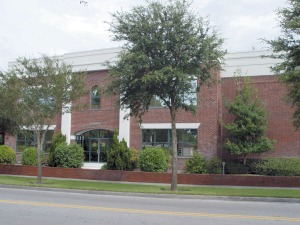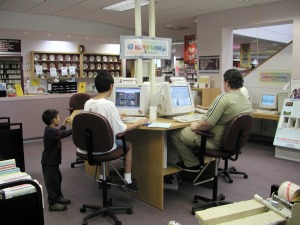HISTORY OF PASCO COUNTYThe New Port Richey Public LibrarySome of the following information is taken from the web site of the New Port Richey Public Library. This page was last revised on Nov. 25, 2018. In April 1919 the Port Richey Press reported Elroy M. Avery has purchased property here and would present to the people of New and Old Port Richey his collection of books as the nucleus of a public library. On Dec. 22, 1919, the Avery Library and Historical Society applied for incorporation. On Dec. 25, 1919, the Port Richey Press reported, “The charter for the new Avery Library has been applied for, and as soon as it is received, a meeting will be held to decide on the general plans for conducting it. Dr. Elroy M. Avery, the noted historian and author, who has his home at New Port Richey, has donated a large number of volumes to the library. Other donations are being received regularly. The new library will have temporary quarters on Main St.” On Feb. 16, 1920, the Port Richey Press reported, “New Port Richey’s Public Library, known as the Avery Library, will be ready for its formal opening in a few weeks. It will start out with almost 1,000 volumes, representing the contributions of Mr. Avery and many other local people. Commodious quarters have been secured in the Snell Block on Main Street. The shelving has been put in place and the books are now being catalogued.” On April 8, 1920, the Port Richey Press reported:
On April 10, 1920, the Avery Library opened to the public in the Snell Building, with more than 2,000 volumes. On March 2-4, 1922, the first Chasco Fiesta was held to raise money to support the library. A total of $364.31 was raised. On Feb. 8, 1924, the New Port Richey Press reported that “for increased protection from fire, the library was recently moved to a safer building.” That refers to the Sims Building. It reported that expenses have been cut to the bone and the librarian’s pay has been cut off and no one draws a cent in pay except the janitress. On Oct. 2, 1925, the New Port Richey Press reported that the library would move to the new Morey-Bowman Building. It reported the library is now open from 3 to 5 on Wednesday and Saturday afternoons. The trustees hope to have it open from 1 to 5 every afternoon except Sundays. On Dec. 6, 1927, city voters approved by one vote the issuance of $15,000 in municipal bonds to build a new library on the Circle. City council decides a second vote should take place, and on June 19, 1928, the bond issue was rejected, 114-73. In July 1928 the library moved to the northeast section of Arcade Building, with three rooms. 7500 books. On Sept. 11, 1931, the New Port Richey Press carried an appeal from Dr. Avery for contributions to the library, which had closed. (The library reopened Tuesdays and Fridays, but the librarian was not paid.) In 1938 the library moved to the new municipal building on Main Street, which was built partly a WPA project. On June 18, 1963, New Port Richey city council voted to change the name of the library to the New Port Richey Public Library, as a new library building at Main and Jefferson was under construction. On June 27, 1963, the New Port Richey Press published letters to the editor from Ralph Bellwood and Rev. John W. Parkes criticizing the decision by the New Port Richey City Council to change the name of the library from the Avery Library to the New Port Richey Public Library. In November 1963 the new building at Main and Jefferson St. was completed. County support for the library began at this time. On March 1, 1977, the New Port Richey City Council unanimously rejected a plan to give the New Port Richey Public Library to the county. The county plan was first advocated by County Administrator Richard Kelton and would have required the city to give up all its rights to the library in return for a $1-per-year leasing fee for 30 years. During the tenure of Donna Riegel as director the Library Board of Trustees turned over governance of the Library to the City of New Port Richey. The New Port Richey City Council authorized a renovation and expansion program in 1987 for the present City Hall and Library. Gee and Jensen Engineers-Architects-Planners, Inc. of West Palm Beach, Florida was selected to design and construct the new complex. The plans called for a 19,000 square foot addition to the City Hall and the Library and the combining of the two into a linked complex with a tower-like structure. The project included a new 24,000 square foot City Hall and a 15,230 square foot Library. The buildings were designed to accommodate city population growth up to 25,000 residents. During this period, the City and County discussed the merging of the City Library into a countywide system. The City Library would provide free library service to county residents. Residents voiced their concerns over the merger and the City Council decided to maintain the City Library and not join the County system. The County passed a bond referendum to fund the construction of a countywide library system. This bond was assessed on the City residents as well and taxation became a point of contention between the City and the County. The City Council has continued to request that tax dollars paid by its residents be returned to the City. Nothing has been resolved as this was written. The building that housed the old Library was to become the new City Hall. The new Library was to be built on the site of the former City Hall. This site was originally an old school building built in 1926. The plans called for the total gutting of the interior of the building with only the three red brick walls left standing. The walls were preserved in order to retain the English Renaissance styling. The City Council authorized the application for a Library Services and Construction Act (LSCA) Grant of $400,000 from the Florida Department of State’s Division of Library and Information Services. The groundbreaking ceremony was held August 30, 1988, with these participants: City Manager, Charles McCool; Mayor Robert Prior; Council Members, Peter Altman, Fran Oreto, and O. J. Brisky; and former Council Members, Jean Rose and Bill Tatum. Bentley Construction of Oldsmar was selected for the Phase One construction of the City Hall. The bid was $2.3 million. The Library was moved to temporary quarters in the Rockville Center Building at 6351 Massachusetts Avenue on February 6, 1989, and remained there until March 1991. These quarters consisted of six units totaling 6,000 square feet. The cost was $2,200 per month. The staff helped to move the approximate 35,000 books. Jane Schwamberger, Library Director, and Tom Huggett of Gee and Jensen Engineers worked on the design and the grant application during this period. The grant was awarded for the amount of $400,000 with a City match of at least $600,000. Jane Schwamberger, Library Director resigned in 1990 during the construction phase. The official grand opening of the new City Hall took place in July 1990. Residents and guests were officially welcomed by Mayor Peter Altman, Council Members Debra Prewitt and Dell deChant, and City Manager Gerald Seeber. Guests were invited to a tree planting ceremony at the building. Members of the West Pasco Sertoma Club and the American Legion Paradise Post No. 79 also attended. The City was presented with a flag, which was raised during the ceremony while the audience sang the national anthem. Susan Dillinger was hired as the new Library Director in October 1990 and continued the building project. Construction on the new library was finished in February 1991. The Library staff assisted professional movers in relocating the Library to its new quarters in March 1991. The Friends of the Library also assisted in the move and provided the new Library with several items. The new library was opened to the public in April 1991. The formal dedication ceremony was held in May 1991, with Mayor Peter Altman, City Manager Gerald Seeber, Council Members Dell deChant, William Partridge, Debra Prewitt, and Nelson Vogel; Library Director Susan Dillinger and guests were in attendance. The Singing Strings provided a classical music setting. The new Library will retain the name “The New Port Richey Public Library.” The Library houses the Avery Conference Room in memory of Dr. Elroy Avery, the founder of the library. The new Library contains over 40,000 volumes of books, audiotapes, videotapes, and compact discs and features adult, young adult, children’s, Florida, genealogy, and business materials. The library is part of the Tampa Bay Library Consortium and the SUNLINE Database, which is a group of libraries which share automation services and materials. The New Port Richey Public Library received LSCA Grant funding in October 1991, for the establishment of an adult literacy program. This program, in conjunction with the Pasco County Schools’ Reading Assistance Program (RAP), instructs adults, through the use of computers, how to read and write. The Library also received a LSCA Collection Development Grant for $25,000 for the purchase of resource materials to support local businesses. The New Port Richey Public Library had registered over half its residents for library services by 1993 and participated in various city events, such as Dr. Martin Luther King Day in Sims Park, and Market Week in conjunction with the West Pasco Chamber of Commerce. Monthly programs have been held in the new Library funded by the New Port Richey Cultural Affairs Committee. These programs have been a great success. The award of another LSCA Grant for the Literacy program came in 1994 in the amount of $35,000. The New Port Richey Public Library continues to grow and strives to provide its residents with quality programs and services. In the 1990s the library remodeled the second floor and expanded the meeting room seating capacity from 50 to 200, as well as equipping the room with computer network and Internet connections. In 1996 the library moved from the GEAC automation system and a Novell network to DYNIX and a Windows NT network. The October 2004 library newsletter listed the following personnel: Susan Dillinger, Director; Tom Keene, Assistant Director; Tracey Pinto, Youth Services; Richard Kleim, Technical Services, Ann Scott, Events and Community Outreach. The hours of operation were Monday through Wednesday from noon to 8 p.m.; Thursday through Saturday from 9 a.m. to 5 p.m. The January 2005 library newsletter reported that during 2004 a new computer network was installed, a young adult room and a foreign language room were created, a new computer reservation system and self-checkout system were installed, a new circulation/information desk was installed, the downstairs of the library was rearranged to provide more computer room, a wireless computer system was installed in the meeting rooms, and a new Events and Community Outreach Department was created to plan and coordinate library programming to the community. In April 2006 at the 83rd Annual Conference and Exhibition of the Florida Library Association, the New Port Richey Public Library was named Library of the Year. Article from West Pasco’s Heritage (1974)By JANET LEWIS
The Dade City Banner for February 11, 1920, carried an article entitled, NEW PORT RICHEY LIBRARY ABOUT READY TO OPEN. It spoke of the “commodious quarters” that had been secured in the Snell Block on Main Street. Shelving had been put in place and the books were being catalogued. At about the same time, in fact on February 18, 1920, the Board of Trustees approved and published the following list of Rules and Regulations of the Avery Library and Historical Society. Today, after fifty-four years of service to the public, some of these rules still relate to library procedure in force at the present time.
On April 10th, 1920, the Avery Library and Historical Society was formally opened, with dedication ceremonies with a collection of slightly over 1,000 volumes from Dr. Avery’s personal library and gifts from civic bodies and private individuals. Dr. Avery supplied the book cases in which to house the books and under the direction of the library committee and Mrs. R. F. Conover the first librarian, classifying and cataloging of books was accomplished. The idea of FOUNDER’S MEMBERSHIP CERTIFICATES was an effort to assure the library of a future and was a fund separate from and additional to regular membership. It was made up of Contributing membership, $10.00 annually; Sustaining membership, $25.00 annually; Life membership, $100.00 annually. There was also Patrons membership on payment of $500.00 or more as the patron wished to make. Cash contributions were also made to insure its future, such as the presentation on March 29th of the “MYSTERY MINSTRELS” aided at the Ball which followed, by Collins Jazz Band of Tampa. A newspaper account of this affair which, by the way, was a “brilliant success”, likened Main Street to 42nd and Broadway on a busy Saturday night!!! The same article went on to say that automobiles were “parked on the landscape as thick as flies.” Many came from Tampa, Tarpon Springs, Elfers, Odessa and Clearwater to the show and at the dance which followed, there were as many as three hundred on the floor of the Ballroom in the Snell Building. This show, sponsored by the New Port Richey Ladies brought a net profit of $268.20 and provision was made to buy the first one hundred books for the Children’s Room. From the first day on which the library opened its doors to the public, the citizens of New Port Richey showed how necessary a library is to a community. Thirty-seven members joined within the first few days and in the weeks that followed, many more books were received by donation. A fund was also established for the purchase of the best new books as they were published. In fact, before very long the book area was showing signs of congestion and more shelving was needed. The cataloging was progressing rapidly and the town of New Port Richey had a modern library. By May 6th, the new Avery Library contained over 2,000 volumes and was proving itself an asset to the community. During that first summer, Mrs. Clyde F. Burns conducted story hours for the children and the New Port Richey Press for July 22nd, 1920, spoke of the young children spending the afternoons in the COOL library, and as late as August not one hot afternoon had been experienced in the library. All were invited to take advantage of the reading room where there was always a cool breeze!!! In the year which followed the opening of the library, much needed financial assistance was provided by the Ladies of New Port Richey, who inaugurated entertainments of all kinds, dances, benefits and card parties, the proceeds of which purchased new books, paid bills and sustained the library in every way. With the formation of a group of ten women, who called themselves the Library Associates, the work of the library was carried on. These women were all volunteer workers and helped the librarian, Mrs. Conover, in every possible way, from shelving and cataloging to cleaning and dusting. It was their joint efforts which instigated the First Chasco Fiesta, the proceeds being turned over to the library fund. As early as December, 1921, at a meeting of the trustees, it was decided to erect a fine fireproof building in a central area, probably near or adjoining the First State Bank as a permanent home for the Avery Library and Historical Society. This step was, it seemed, rendered necessary for the protection of its large and valuable collection of books against fire and also the need for more space in which to house them. The idea was to be more fully discussed at a later date and it would appear that such a need was imminent as the library was then being kept open daily during the winter season. In 1921 and 1922, there was much publicity on a forthcoming City Directory which was being compiled by Dr. Avery and which was to be published under the auspices of the Avery Library and printed by the New Port Richey Press. A great deal of work must have been accomplished on this project although it does not seem to have reached completion and no records are available on the publication itself. In May, 1922, a delegation from New Port Richey attended the third Florida Library Association Convention being held in Tampa and Dr. Avery was made Vice President of the Association at that time. Throughout these early years of the library’s growth it is evident that the guiding hand of Dr. Avery was behind the many endeavors made to support the library financially. Through the New Port Richey Press which was solidly behind the library and gave it much publicity, we learn of the many concerted efforts made to support this institution. In 1923, Dr. Avery launched a budget drive for the coming year, calling for at least $800.00 over and above the $150.00 in membership fees which shows that one hundred and fifty citizens had become library members. In a brochure published at that time and entitled “Our Library, Do we appreciate it enough to support it?”, Dr. Avery made the following statement. “Tarpon Springs is two or three times as large as New Port Richey, but its library is much smaller than ours. The Tampa Library has one book for every three inhabitants; our library has four books for every one of our population.” He went on to point out, however, that the library needed the support of its members. “In 1923, the expenses of our library exceeded its income from all sources. It was possible only because of the surplus provided by the labors of the Library Associates. The pay of the librarian has been cut off and the cost of Saturday evening service has been eliminated. No one draws a cent as an employee except the janitress …. To this end every lover of books (man’s most faithful friends) should help as he or she is able. Make a pledge (subscription) for the Library’s Maintenance Fund for 1924, and send it to the treasurer of the Avery Library, New Port Richey at once. By so doing, you will save the trustees the expense of sending a solicitor to you and save yourself from the annoyance of any further appeal for the rest of the current year….” The money was obtained and the library survived for another year. The year 1924 was to see many changes in New Port Richey. The town was to become an incorporated city and the library trustees in October 1925 offered to give the library with all of its collections, funds, and equipment to the City of New Port Richey. On the 20th of October, and as authorized by the city charter, the City Council adopted its Ordinance No. 29, accepting the offer, establishing the Avery Public Library and providing for its government and maintenance. The ordinance was approved by Mayor Avery three days later and became operative on the 2nd of November, 1925. The first Library Board consisted of Mrs. Ella W. Avery, Mrs. Alma H. Kilborn, Mrs. Kate H. Dane, The Rev. O. H. Denney and L. G. Marston. As soon as Mayor Avery made the Board (which he did, by resigning his office as Mayor, in December), his wife resigned as a member of the Board and he was elected to the vacancy thus created. At the time of its adoption by the city, the Library accession book listed 4,854 volumes. The increase in the number of volumes was due partly to purchase, but more largely to gifts by members and library friends. The largest gift received was from the Cleveland Public Library and from time to time a book will turn up in 1974, with a Cleveland Public Library stamp on the title page. In the first Annual Report to the City in June 1925, Dr. Avery cited the cost of a library having to pay rent for the use of the building which housed it. He said. “We shall have to spend two-thirds (64 per cent) of our half mill tax for rent. In short, rent is the monster that is gnawing at the vitals of the library. The other public libraries having no rent to pay can distribute or budget one hundred per cent of their income, while we having rent to pay, can budget (next year) only thirty-six per cent of our income for the same items. In other words, these public libraries that occupy their own buildings have nearly three times as much available income as we have, for maintenance and growth. We need a library building worthy of the city, worthy of the beautiful site already provided for it, and we need it quickly. I would that these facts might sink deep into the consciousness of the members of our city administration and energize them to the prompt action needed…. Louis I. Holway became librarian of the Avery Library on appointment by the Board at a meeting on December 2, 1925. He and Mrs. Holway had visited the library and Mrs. Holway had remarked to Mrs. Avery “My husband is at home in a place like this!” Dr. Holway, a minister from a township in Vermont, had come to New Port Richey as appointee to the little church on the circle. He had also carried on library work in the township where he had his ministry had brought library privileges into the schools in his district, and had instituted two new adult branches. With the consent of his church, he accepted the position of librarian which he held until his death. Writing about his life as librarian, Dr. Holway told of the three moves which the library had made under his administration. First, to the building known as The Peninsular Building; next, to one of the three room sections of the Post Office Building; and lastly, to its location in the Municipal Building at 113 Main Street. In each instance of change the quarters eventually proved too small or too unsuited to the library’s needs. In 1927, Dr. Avery was writing, “What we need is a building of our own.” In August 1927, in an impressive speech before the City Council, Dr. Avery spoke of the possibility of a permanent library building. Members of the Council took the matter under advisement with the intention of securing definite action as soon as possible. It was conceded that a new building, on the site already provided for this structure, would be the answer for all time, to the library moving proposition, and at the same time provide the city with a building in keeping with its growth and general beautiful appearance. From a library of 4,853 books when the city took over the original Avery Library and Historical Society’s interests and opened it afresh November 1, 1925, as the Avery Public Library, it has grown to be a library of over 16,700 accessions. Your librarian has added in those years, nearly 2,500 new names to its patrol roll. Its circulation for its recent year of service was a few hundred short of 12,000. Its opportunities for research, especially in the Department of United States history, gives it a prestige among the many libraries of Florida….” When Dr. Holway died in March, 1948, after an attack of flu, his dream to see the library, to which he had dedicated twenty-three years, in its own building, had not yet been achieved. 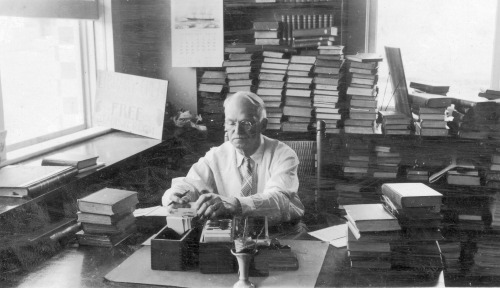
On June 19, 1928, however, the Avery Public Library Bond issue was defeated. The bond issue which had passed at a previous election by one vote, which to the city officials did not constitute the total will of the people, was defeated. One prominent citizen, who had worked for the passage of the bond issue said, “This election was hardly representative, many of the large property owners being absent on vacations in the north. Had they been here, there would have been a different tale to tell. The vote would have carried. Undoubtedly, it will be put to a vote again this fall.” To the great surprise of the Library Board of Trustees, Dr. Avery tendered his resignation from the Board in January, 1929. In a letter to the Council he expressed discouragement over the Council’s failure to grant the library an increase for the coming year. The Council on the other hand, stated that at the request of citizens, it felt that it could not grant the increase requested. It was a time when emotions seemed to take over. Dr. Avery was now about eighty-five years of age, but the Library Board felt that as founder, he would also remain its benefactor and that his will would remain unchanged. Consequently the Board refused to accept Dr. Avery’s resignation and voted to make him an honorary member for life, permitting him to be active or inactive as he saw fit, all the councilmen feeling that he had done so much for the library that he should thus be recognized.
In the many years which have passed since Dr. Avery presented his initial gift of one thousand books the Avery Library and Historical Society, some have worn out from years of use, about four hundred have been locked away for preservation, but many seem to have disappeared. A recent inventory brought to light the first book to be accessioned, No. 1. It was, of course. Dr. Avery’s personal copy of a Scofield Bible. Dr. Holway tells of Dr. Avery visiting the library frequently and bringing from time to time some notable addition to the collection. One day he brought a copy of a book with the description on the cover “The Secret Log Boke of Christopher Columbus, noted and written by himself in the years 1492-1493 – Discovery of America – Fished up on the 14th day of August 1890 and imitated after the original Log Book. . .” The book is printed on parchment and is, of course, one of the special collection. At a District Meeting of the Florida Library Association which the Library Staff attended in St. Petersburg, in 1929, Dr. Louis Holway wrote of the special display of Dr. Avery’s books which were placed on exhibit at the Suwannee Hotel, where the meeting was held. In the same year Mrs. Warren E. Burns donated a set of twenty volumes of the “Fundamentals of Musical Art” to be placed at the sole disposal of the Musical Club, of which she was a member. These volumes could be looked at in the Reading Room only. Today, some still exist but may be borrowed by the public. The Library was having the same difficulties in those early years, which still plague all libraries today, especially the return of overdue books. Thus from time to time the Library Board had to amend the Rules and Regulations governing library procedure as the population grew. When it was a City Library only, persons living within the County and within a radius of ten miles paid an annual fee of two dollars. Tourists could use the library by paying a two dollar deposit or if they wished only one book, could pay the cost of the book at the time of rental with the money to be returned when the book was brought back. Children attending the local schools, from neighboring cities, paid fifty cents a year. Even then, Dr. Holway noted the growing carelessness about the prompt return of books when due. Very concise records have been kept through the years, relating mostly to book purchases and cost of operating the library. It is amazing how much was done with so little and the answer can lie only in those dedicated people who had the library at heart. In an entry for May 19, 1946, the secretary of the Library Board, Mrs. E. J. Belcher, reports a request for a two month leave of absence with full pay, which was granted to the librarian. In his absence, Mrs. Marion Heckroth, a Board member, was appointed as substitute librarian at a salary of five dollars a week. In the Annual Report for the same year, it was discovered that due to the resignation of Board members from time to time and new members elected to fill the unexpired term of office of retiring officers, that the terms of all members had run out. It was necessary to ask Council to approve the re-election of all the members! The names sent to Council at that time were Miss Maud Thompson, for 1 year; Mrs. Belcher, 2 years; Rev. F. H. Andrus, 3 years; Mrs. Heckroth, 4 years; and Mr. Fenton, 5 years. There was little money in those years to support a library. The town was small and the annual report for that year showed that twenty-seven books had been purchased at a cost to the city of forty-five dollars and eighty-seven cents. It was the donations that gave the library so much help in those days. Books came from the Cincinnati Public Library, from the Finnish community and from local friends and patrons. The gifts in that year totaled over nine hundred books, all of which were lacquered to preserve them. The Public Libraries had always rebound books before they went on the library shelves, even when just from the publisher. This added years to the book, but with the advent of library binding by publishers, which did not exist then, libraries no longer follow this course. Also in that year one hundred and forty patron names were added to the list of borrowers and for the first time the library had a Children’s Corner!
Dr. Holway was succeeded by Laura Powell as librarian. At that time the library was in the Municipal Building at 113 E. Main Street and was to remain there until 1963, when it moved to its present site. Miss Powell came to New Port Richey, also from Cleveland, Ohio, the home of Dr. Avery. Like him, her life had been spent there as an educator and teacher of wayward girls. Not only did she understand the Dewey Decimal system of classification, but she understood people, and in the seven years as librarian, she was a strong guiding hand in the growth of the library. Although a plaque was to be made to honor Dr. Holway’s twenty-five years as librarian, Miss Powell also felt that a system of placing books as Memorials to the memory of the deceased, by relatives and friends should be adopted. Not only would it help to bring in good books which the library sadly needed but could not afford, but it would also serve as a tribute to those who had died. The Memorial idea was very successful, many feeling that it was a much more permanent form of remembrance than flowers. In the first months as Librarian, Miss Powell also served as secretary, pro tempore, as the minutes of several Board meetings of that time show. During her tenure as librarian, she saw many changes in the reading habits of the community, one media of which left a strong impact. This was the coming of television. Writing her weekly article to the Press, in one of them in 1954, she remarked, “I have been thinking much recently about the impact of television on the reading habits of young and not-so-young America. From time to time, one hears ominous details about the inroads this new media is making upon readers of all ages. Librarians can be and are among the best judges of this situation, due to their daily contacts with books and the public.” But she continued to express some doubt as to whether or not the media would be helpful or harmful, as it seems that some librarians felt that “far from creating a nation of blurry-eyed morons, television has given viewers a glimpse of some subject, whereby whetting the appetite and sending them off to the library to pursue their interests further.”
As librarian, Miss Powell worked alone much of the time as had Dr. Holway. In 1950, the library was open twenty-two hours a week, being closed all day Thursday. These were twenty-two very busy hours and Miss Powell asked a member of the Board to assist her. This member, Barbara Clark, helped from time to time as a part time assistant, but who in this way gained from Miss Powell a very basic working knowledge of library procedure and of the system being used then, the Dewey Decimal system. Mrs. Clark was to become librarian at a later date. Miss Powell was an innovator and under her guidance the library adopted many new methods, but ill health forced her retirement in 1954. In Ellene Kroll’s term of librarianship from 1954-1959, the Smokey Bear Summer Reading Program, sponsored by the State Forestry Service, was begun. In the limited space at 113 E. Main Street, the Children’s Corner must have been quite a hubbub on the days which the children met, but under the supervision of Assistant Barbara Clark, who had been an elementary school teacher, children spent many pleasant hours. A large fan had been purchased and, it is to be noted, that at no time is there any complaint registered over any undue heat in the building. Miss Powell’s “Library Notes” appeared weekly in the Press and in one article for November 25, 1949, she wrote, “Another milestone was passed this week in library service to the community. The school and settlement library opened in the Booker T. Washington School on Monday, for the colored people of that area. The books are largely duplicate copies taken from the shelves of the Avery Library. There are around two hundred volumes which include fiction, history, reference material and a good selection of classics in American literature… The Library Board feels that this project is one of its most worthy achievements…” Another column for June 6, 1952, begins: ” Are there any citizens in this locality who have been familiar with the organization called “Friends of the Library,” who they are, what do they do?” She spoke of the organization in Clearwater as a wide-awake group, making possible many of the modern features necessary for the people to enjoy. From 1930 to 1956, the library did not bind annual copies of the New Port Richey Press. However, much scrap book material has been kept by the librarians, Dr. Holway, Miss Powell and Mrs. Kroll. From 1956 on, the New Port Richey Press has been bound annually and today all New Port Richey newspapers are being bound. Ellene Kroll, who took over after Miss Powell’s retirement in 1954, found a library room bulging at the seams with books and magazine material. She, too, kept the weekly library news to the local paper very much alive with her column, “The Library and You.” She also inspired the idea of a “Friends of the Library,” in 1955 and in 1956, although the group did not organize until 1963, under the direction of Barbara Clark. Richard Williams became its first President and for some years it was a very active organization. It is at present inactive for lack of working officers. There is, however, one article which unfortunately is not dated but which appeared among her columns in the scrap book around November 1955, which showed a picture of the crowded library, with the librarian and a library member, Mrs. Louis Thys. The heading is “Council covets library space but cramped facility itself needs more room, money.” It quoted the library as then having 18,000 volumes, with reference books stacked on shelving ten and twelve feet high; that Council was eyeing the area as a solution to the need for additional space for the City Hall staff. It mentioned the four locations which had housed the library since its founding: the Snell Building; the Morey-Bowman Building on the Boulevard, in 1924. Then in July, 1927, it moved to three rooms in the Post Office Arcade Building and in 1938, moved to the Municipal Building at 113 East Main Street. The sixty-four dollar question was the financing of a new building with the city under pressure of financing a new sewer disposal plant, extending and enlarging the water works and paving streets and so could “ill afford an appropriation of thirty or forty thousand dollars for a new library building and maintain the present “pay as you go” policy.
In 1959, Mrs. Kroll’s association with the library was sadly terminated with illness and death and Barbara Clark was asked by the Library Board to take over the position. No one was better equipped to do so. Mrs. Clark had profited greatly by her association with the two previous librarians, serving under Miss Powell since 1950. She knew the need for library expansion better than anyone else. The library continued to grow and in 1962, Estelle F. Garner became Mrs. Clark’s assistant. Despite the cramped space, children’s books were borrowed on long term loan from the State Library. The Smokey Bear Summer Reading Club was well organized and just about all the children in the community attended. The highlight of these summer programs was a trip to Busch Gardens with buses being furnished by the School Board. Mrs. Clark also worked with the City on the need for a new library building. In the New Port Richey Press for May 16, 1963, there appeared an architectural drawing headed.. “Another sign of Progress” … showing how the New Port Richey Public Library would appear when built at the site chosen, namely 302 East Main Street. The new building would occupy approximately 4,490 square feet of space. The caption quoted the number of volumes then in the city hall building at about 20,000.
On May 23rd, 1963, ground-breaking ceremonies for the new Public Library were held. Participating were Mayor C. E. Kohler, Councilmen Frank Smith, Hugo Kovisto and Robert Gwynn; also Barbara Clark, librarian, and Dr. Robert Hartzell, President of the Library Board. The building was constructed by The Driggers Construction Company of Tampa and completed in November 1963. No time was lost in moving into the new building. There is the story of that move. Mrs. Clark and her assistant, Mrs. Garner, filled boxes of books in the precise order of shelving and marked them for the movers to follow implicitly. They did not count on the shelving not arriving on time and the need for haste by the city employees who moved the books. The result was chaos!! It all ended with the old shelving being literally torn from the walls with long nails still protruding. They were set up in the greatest disorder and long boards were placed on wooden horses to support many of the books. Little scraps of red cloth were tied on the nails left in the shelving, books were crammed on the shelves and the library opened in two days for business.
The job of complete reorganization, of course, had just begun and shortly after opening, Virginia Reuss, a library cataloger, began the stupendous job of creating a new catalog. It was a tremendous task for Librarian Clark, but 1964 statistics show a decided increase in circulation. The area around New Port Richey was beginning to develop. The County was growing in population and what had once been large wooded areas were beginning to give way to housing projects which grew into large subdivisions. From 1963 on, the County growth began to show in the registration of library borrowers from neighboring communities. As this growth began to exceed the number of city patrons using the library, the Board began to feel the necessity of asking the County Commission to assist in the financial support of the library. Until the new building was constructed, the library had been a city supported enterprise. The city had furnished the land, the building and all the equipment, including desk, shelving, tables, chairs, etc. The name had been changed from the Avery Public Library to the New Port Richey Public Library. It was no longer a city library but a community library. The City of New Port Richey could not carry the entire burden. Since that time the County has assisted in its support.
Since 1965, the growth in the system has been unprecedented. In 1966, a Periodicals Room and Auditorium to seat seventy-five people, was added to the main building. Sponsored by the Library Board, Mrs. Lewis began a series of afternoon programs for the public. These consisted of Book Reviews, illustrated lectures and many other special types of programs. Puppet shows were included in the Summer Reading Programs for the children, and the auditorium has proven to be a wonderful asset for many children’s programs, when school is not in session. The success of these programs has, however, shown that the auditorium is becoming too small to accommodate the people who attend. In order to serve the public better it was imperative that the library extend the hours which it was open. A revamping was necessary, eliminating the closing each day from 5:00 7:00 which was found to interrupt service to the public, especially students. Since 1969, the library has been open fifty-nine hours a week. Much more shelving was needed as it expanded. The registration of patrons is now on an average of two hundred and fifty borrowers a month The annual circulation has reached over 180,000 and keeps soaring. With the present system of renewing the borrowers’ cards every three years, the library can keep an accurate count on the number of city and county patrons registered and using the library today The library subscribes to about fifty magazines, with gift subscriptions from patrons of about the same number. It carries all the local newspapers and the Wall Street Journal, a gift of many years standing from the First National Bank. The desk area, supervised by Muriel Kelly, has recently been expanded and with so much added shelving, the library is beginning to take on something of the appearance of the old building at 113 East Main Street, crowded. In a special area set aside as the Mrs. Warren E. Burns Memorial Room are the Large Print books, the Floridiana and the Memorial books. The Large Print books, a project first begun with a gift from the New Port Richey Lions Club, which is continued with an annual donation by the Club, presented each year during National Library Week. It is also supported by many very generous memorials evidenced by a wall plaque with the names of persons and groups who have donated one hundred dollars or more to the project. The Memorials area continues to grow also and with this money some of the finest books in the library have been purchased. The auditorium now contains wall shelving to accommodate the many gift replacements and new additions to the book collection waiting for processing when needed by the library. The library is staffed with two full time workers, the librarian and the desk supervisor. Other members of the staff are Betty Wolford, assistant cataloger, Ann Hildebrand, assistant, Estelle Garner and Jean Englemen. The six year period from 1968 to 1974 has been one of tremendous growth on Florida’s West Coast. Thanks to the efforts of a group of dedicated individuals, the New Port Richey Library has kept pace. Plans for the future include the possibility of converting the auditorium into a working area which will probably house the Reference Department. Today, at the library, the spirit of Dr. Avery remains very much alive. Library AssociatesBy JANET LEWIS Shortly after the Avery Library and Historical Society had been established, an organization was formed which was to play a large part in developing and creating a cultural atmosphere in New Port Richey, as well as forming a very practical and necessary need for the survival of the library. Mrs. Cornelia Conover, the librarian, soon realized that there was an enormous amount of work to be done, besides the actual routine work of the librarian. She invited ten ladies to her home (December, 1919) to talk over what was to be the beginning of the Library Associates, an organization whose objects were to serve the library in any and every capacity, from janitor service to care of the books, and to earn money for the library treasury. At the second meeting of the group, Mrs. Conover consented to act as President and Mrs. Elroy Avery was appointed Secretary. It was also decided that an entertainment should be held each month for the benefit of raising funds. The Library Associates consisted then of fourteen members (all women), and the entertainments met with varying degrees of success, but in 1921, due to added pressures of work in the library, Mrs. Conover resigned as President and was succeeded by Mrs. F. Salisbury. During that first winter of 1920-21, the Library Associates were able to make a gift of one hundred ninety-eight dollars and forty-five cents to the Library treasury. The second year showed a larger membership in the Associates and it was decided to nominate officers. The committee presented a slate as follows: Mrs. F. Salisbury, President; Mrs. Preetorius, Vice President; Mrs. Conover, Second Vice President; Mrs. Avery, Secretary; and Mrs. Sass, Treasurer. These officers were elected for a three year term and all held office for that length of time, with the exception of Mrs. Sass whose office was filled by Mrs. Schoolcraft. In the second year of its existence, under Mrs. Salisbury, the Library Associates considered several ways of making money for the library and many plans were discussed, until it was finally decided to give “One Grand Carnival”! Tentative plans were carefully drawn up, discussed by the officers and advice was asked on this project, from men whose judgment and opinion were valued. With much encouragement, the Executive Board had faith to believe that this great undertaking could be successfully carried out. A special meeting of the Library Associates was called and a number of men who had promised assistance were also invited. With such added encouragement, the Associates voted that the tentative plans be adopted and carried out. The name chosen for this great carnival was the Chasco Fiesta. The name was proposed by Mrs. Preetorius, who said that the name of the river Pithlachascotee suggested it to her. Pithlachascotee furnished the names of the hero and heroine of an Indian legend, written by Gerben DeVries, in which the hero was Prince Pithla and the heroine Princess Chasco. The story was printed in booklet form and sold for ten cents per copy. For weeks the Chasco Fiesta was the topic of the whole populace. Men, women and children worked for it and in it and the great three day Fiesta of March 2, 3, and 4, 1922, was staged. One of the big features of this carnival was the Moonlight Cabaret, staged under the personal direction of Mrs. Howard Ashton, a visitor (tourist). The Fiesta netted the good will of the entire community and more than three hundred dollars for the Library Associates treasury ($364.31). The entire proceeds for the season of 1921-22, over four hundred dollars, were presented to the Library Board of Trustees. In its fourth year, Mrs. Wilcox was elected President of the Library Associates and it continued to assist the library financially and in many other ways. Mrs. Randall succeeded Mrs. Wilcox as President in its fifth year and it is of interest to note that the total proceeds furnished by the Library Associates to the library in its first five years of activity, amounted to a grand total of $1,180.68!!!
Library Directors
|

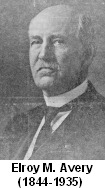 During the month of June 1919, Dr. Elroy McKendree Avery arrived in the
town of New Port Richey, bringing with him part of his collection of
many hundreds of volumes, which he intended presenting to the town as a
nucleus of a public library.
During the month of June 1919, Dr. Elroy McKendree Avery arrived in the
town of New Port Richey, bringing with him part of his collection of
many hundreds of volumes, which he intended presenting to the town as a
nucleus of a public library. 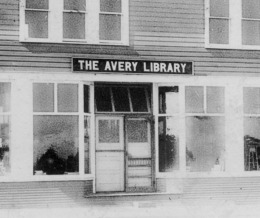 Under the articles of incorporation, Dr. Avery was elected President,
Charles F. Hoffman, Vice-President,
Under the articles of incorporation, Dr. Avery was elected President,
Charles F. Hoffman, Vice-President, 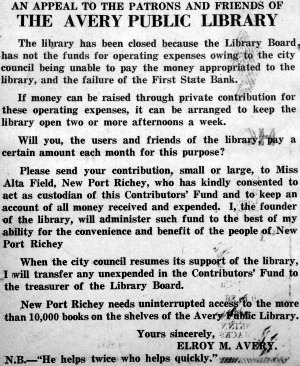 In 1931, the Avery Public Library closed. In 1931 the First State Bank
failed, and Council was unable to pay the money appropriated to the
library as it did not have the funds. Dr. Avery in the September 11th
issue of the Press requested that users and friends of the public
library try to pay a certain amount each month to keep the library open.
He asked Miss Alta Field of New Port Richey to be custodian of the
contributions and he as founder of the library offered to administer
such fund to the best of his ability. When the city resumed its support
of the library he would transfer any unexpended moneys in this
Contributor’s Fund to the treasurer of the Library Board. This
calamity to the library continued for some time and Librarian Holway
reported that Dr. Avery’s appeal had brought some response, but
not nearly enough. The Library was kept open (somehow) each Tuesday and
Friday and the librarian was found always on the job. Little by little
the library received more assistance, but not enough to pay the
librarian. Nevertheless, Dr. Holway continued to keep the library open
and church organizations and local lodges responded with financial help,
for the sake of the students of the high school who depended on the
public library.
In 1931, the Avery Public Library closed. In 1931 the First State Bank
failed, and Council was unable to pay the money appropriated to the
library as it did not have the funds. Dr. Avery in the September 11th
issue of the Press requested that users and friends of the public
library try to pay a certain amount each month to keep the library open.
He asked Miss Alta Field of New Port Richey to be custodian of the
contributions and he as founder of the library offered to administer
such fund to the best of his ability. When the city resumed its support
of the library he would transfer any unexpended moneys in this
Contributor’s Fund to the treasurer of the Library Board. This
calamity to the library continued for some time and Librarian Holway
reported that Dr. Avery’s appeal had brought some response, but
not nearly enough. The Library was kept open (somehow) each Tuesday and
Friday and the librarian was found always on the job. Little by little
the library received more assistance, but not enough to pay the
librarian. Nevertheless, Dr. Holway continued to keep the library open
and church organizations and local lodges responded with financial help,
for the sake of the students of the high school who depended on the
public library.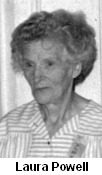
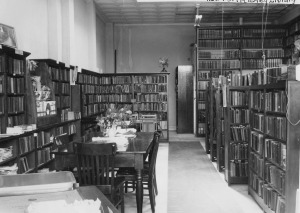
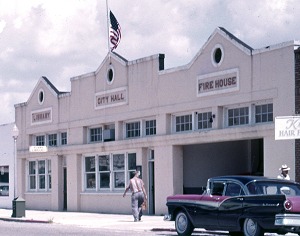
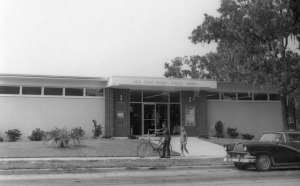
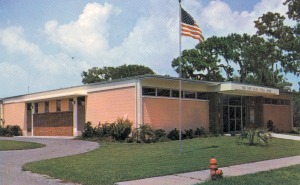
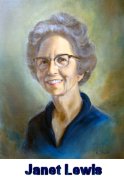 In May, 1965, Librarian Barbara Clark retired
from the position after fifteen very active years of
library growth. The Library Board appointed Janet
Lewis, who had been associated with the Cleveland
Public Library for many years before coming to Florida. Mrs. Lewis took
over at a time when the growth
of the community was to be felt in the library system
as never before. Mrs. Clark had felt the need for a
new mechanized system of book distribution, to promote greater accuracy
and efficiency. The old, easy
method was too slow. The library was open forty
busy hours a week and so in 1965, the Library Board
decided to change to the Gaylord system of charging
which is still in use today. This system has served
the library very well and with the Rolodex system of
checking all borrowers, the library can keep a constant watch on fine
accumulations and overdue books.
In May, 1965, Librarian Barbara Clark retired
from the position after fifteen very active years of
library growth. The Library Board appointed Janet
Lewis, who had been associated with the Cleveland
Public Library for many years before coming to Florida. Mrs. Lewis took
over at a time when the growth
of the community was to be felt in the library system
as never before. Mrs. Clark had felt the need for a
new mechanized system of book distribution, to promote greater accuracy
and efficiency. The old, easy
method was too slow. The library was open forty
busy hours a week and so in 1965, the Library Board
decided to change to the Gaylord system of charging
which is still in use today. This system has served
the library very well and with the Rolodex system of
checking all borrowers, the library can keep a constant watch on fine
accumulations and overdue books.